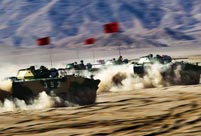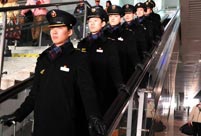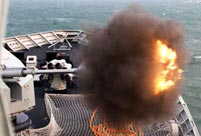 Cockfighting show staged in E. China's Heze during Spring Festival
Cockfighting show staged in E. China's Heze during Spring Festival
 Chinese New Year Flower Fair opens in San Francisco
Chinese New Year Flower Fair opens in San Francisco
 Festivities in Shanghai
Festivities in Shanghai
 PLA navy conducts drill in North China Sea
PLA navy conducts drill in North China Sea
 World's high-tech hotels
World's high-tech hotels
 Li Na poses with trophy on Brighton Beach in Melbourne
Li Na poses with trophy on Brighton Beach in Melbourne
 Six Chinese divers back safely after 300-meter saturation dive
Six Chinese divers back safely after 300-meter saturation dive
 Traditional wedding ceremony of Yao people
Traditional wedding ceremony of Yao people
 Taipei Game Show attracts geeky gamers
Taipei Game Show attracts geeky gamers
WELLINGTON, Feb. 4 (Xinhua) -- The Last Post the iconic bugle call still heard in parts of the former British Empire to commemorate the military dead might soon be telling navy divers around the world that they've just failed an exercise in seabed mine training.
The tune is incorporated in a diver training system known as METRES Maritime EOD (explosive ordnance device) Training, Ranging and Evaluation System developed by the Defense Technology Agency (DTA), the science and technology arm of the New Zealand Defense Force.
It is one of a range of new technologies, spanning seabed mines to state-of-the-art avionics, that could see New Zealand's military become a minor, but significant player in the global military equipment market.
The United States Navy purchased six of the METRES systems in November last year, prompting DTA director Dr Brian Young to anticipate interest from other military organizations.
METRES, a replica mine that sits on the seabed and can be configured to the specifications of a variety of mines, carries sensors that can detect the noise or activity of approaching divers. Its reactions include a light that goes on when a diver is detected and the worst case scenario a rendition of The Last Post through its underwater speaker to signal an explosion.
USEFUL TOOLS
But the black humor belies the DTA's expectations that it could be a provider of leading technologies to global superpowers.
The agency also claims to be fielding inquiries into its development of unmanned aerial vehicle (UAV) avionics, and boasts world-leading technologies including maritime environment monitoring, automated radar tracking, engine diagnostics and materials analysis, simulation, and data fusion.
"Some of these have potential commercial value, some do not," Young said in an e-mail interview with support for the New Zealand Defense Force (NZDF), which, Young stressed, was the agency's main focus.
He cited the UAV avionics systems as an example.
"Like all militaries, the NZDF regards UAVs as a useful surveillance tool. The UAV developed by DTA was deployed in Afghanistan by the NZDF, although it was actually built only as an experimental platform. It is however a highly capable system, but in its current form is probably too complex and insufficiently rugged for most general military surveillance purposes," he said.
"The avionics, however, are extremely capable and reliable with numerous features, including ability to function in a GPS-denied environment; beyond-line-of-sight operation for pre-programmed sensing and photography; payload control, gimballing, camera stabilization and geo-pointing; flight termination on critical failure with return to base and parachute landing."
FAST TECHNOLOGY TRANSFER
The DTA employs 80 civilian scientists, engineers, technicians and support staff who mostly work from the Devonport Naval Base in Auckland, while others are based at NZDF Headquarters in Wellington.
Projects underway for the NZDF include the upgrade of the navy' s two frigates and the development of the Network Enabled Army capability to enhance command and control systems and improve the NZDF's ability to operate with other nations' forces.
They also work with other government agencies and are currently developing an improved system of maritime vessel tracking in cooperation with Customs, the police, the Ministry of Primary Industries and maritime safety organizations.
But Young envisaged fast technology transfer as the core of the DTA's commercial developments.
"This reduces the amount we earn from our intellectual property, but it allows us to focus on our core business," he said.
"It also means there is a relatively low cost associated with commercializing a technology that was developed in the course of our day-to-day work for NZDF, so any subsequent earnings from the technology are mostly profit. This differs from organizations that develop technologies solely for the purpose of taking them to market."
CAPABILITY DEVELOPMENT
Developments with commercial potential are licensed out to commercial partners, who are subject to the Export Control regime of the Ministry of Foreign Affairs and Trade.
The commercialization of the METRES system was licensed out to New Zealand defense and aviation equipment provider AAL, but neither AAL nor the DTA would reveal the value of the contract with the U.S. Navy.
AAL director Paul Taylor, who previously served 21 years in the New Zealand navy, told Xinhua the cost of each METRES system varied considerably depending on the configuration and whether services such as training were included.
Asked in a phone interview how the company had marketed METRES before the sale, he replied: "We just responded to a tender it was an open tender."
DTA's potential as an exporter was recognized in November 2011, then the NZDF announced it was implementing the recommendations made in an independent review of the DTA commissioned by then Defense Minister Wayne Mapp.
"In the future we will be looking to the DTA to generate income which will be reinvested in our military capability," Chief of Navy, Rear Admiral Jack Steer, who was then Vice Chief of Defense Force, said in a statement.
"Science and technology is an increasingly important part of our military capability so the NZDF will be looking to the DTA to provide more direct support for our capability development."
If The Last Post spreads to diver training courses abroad, it might signal Reveille for the NZDF's plans to become a military equipment provider.
 3D film 'The Monkey King' premieres in Beijing
3D film 'The Monkey King' premieres in Beijing  Miss Chinese Int'l Pageant 2014 held in Hong Kong
Miss Chinese Int'l Pageant 2014 held in Hong Kong 'Golden Flowers' in the Spring Festival travel rush
'Golden Flowers' in the Spring Festival travel rush Li Na beats Cibulkova to win Australian Open
Li Na beats Cibulkova to win Australian Open Sexy models at Taipei Game Show 2014
Sexy models at Taipei Game Show 2014 'Living in ice house' competition held in central China
'Living in ice house' competition held in central China  Highlights of Chinese airborne troops'exercises
Highlights of Chinese airborne troops'exercises  All-male high speed train crew during Spring Festival travel rush
All-male high speed train crew during Spring Festival travel rush PLA navy drills in East China Sea
PLA navy drills in East China Sea President Xi visits border troops ahead of Lunar New Year
President Xi visits border troops ahead of Lunar New Year What do Chinese pack in their luggage in Spring Festival Rush?
What do Chinese pack in their luggage in Spring Festival Rush? Blind date fair in Hangzhou of Zhejiang province
Blind date fair in Hangzhou of Zhejiang province Film 'Where Are We Going, Dad' premiered in Beijing
Film 'Where Are We Going, Dad' premiered in Beijing  Australian Open champion Li Na returns to hometown Wuhan
Australian Open champion Li Na returns to hometown Wuhan Twin sisters serve during Spring Festival travel rush for the first time
Twin sisters serve during Spring Festival travel rush for the first timeDay|Week|Month